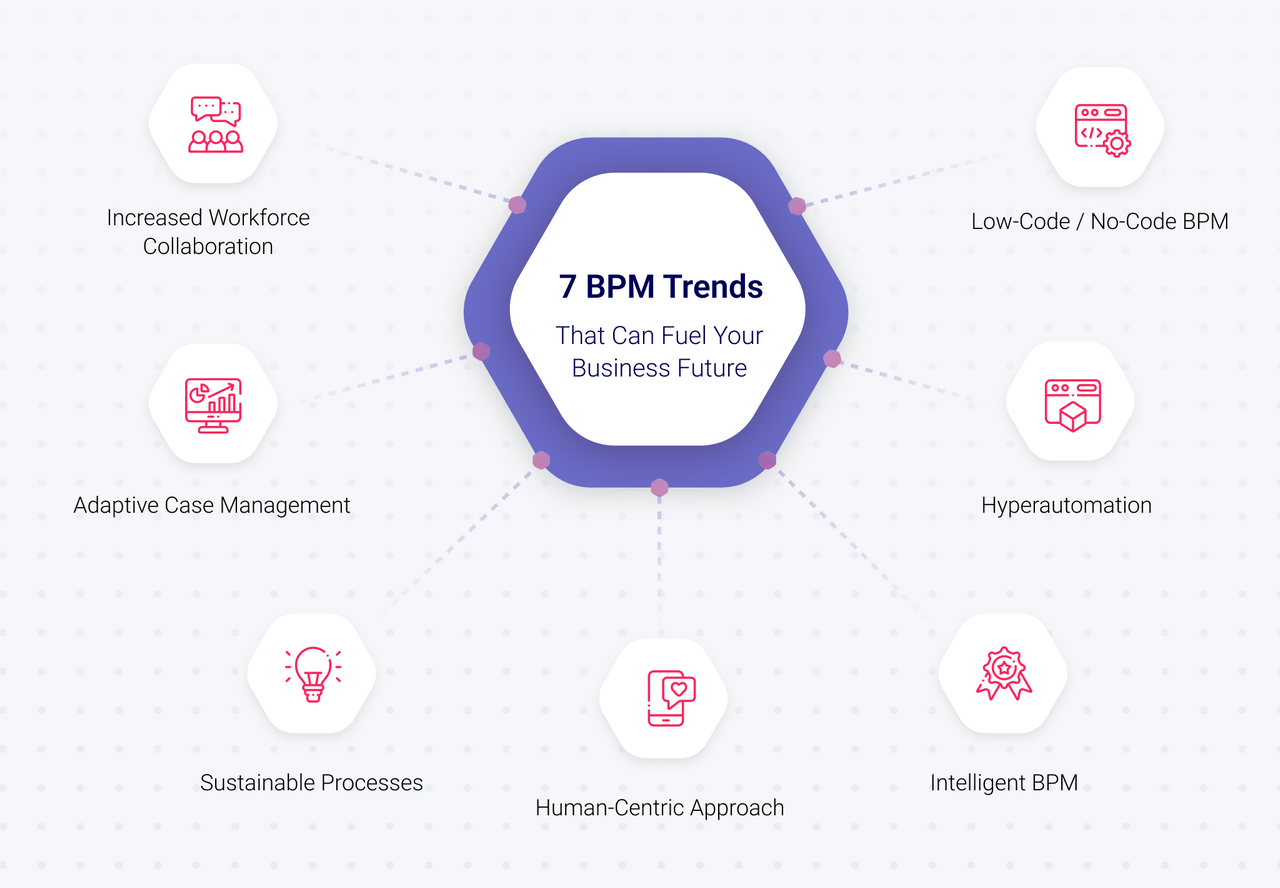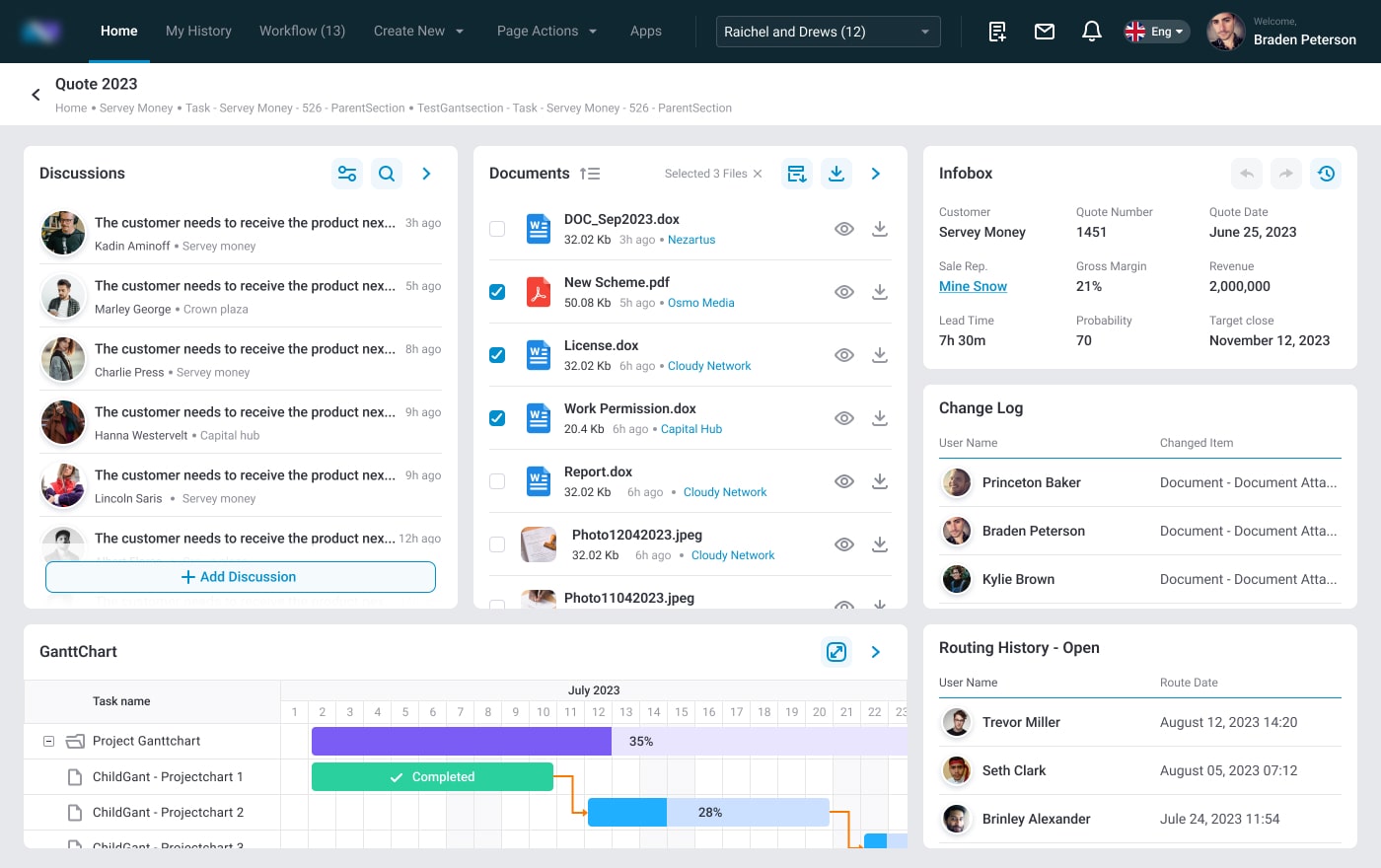Summary
The article explores seven key BPM trends shaping the future of process automation, including low-code/no-code development, hyperautomation, and intelligent BPM powered by AI and process mining. It also highlights a growing shift toward green BPM, adaptive case management, and human-centric design, as organizations prioritize sustainability, agility, and user empowerment.
The processes of any business create a complicated network connecting a variety of operations, decisions, resources, and people involved. The more activities are included, the more business process management (BPM) becomes complex. To improve the approach by automating some operations and decreasing time spent on them, BPM software solutions are often used. The best business process management software helps to reduce risks of human error, gives more visibility into process performance, and lets employees focus more on those tasks that require human expertise and interventions.
Besides using BPM systems, there are many other useful trends that fuel the future of business process management. Therefore, in today’s article, we will take a closer look at 7 useful technology trends in BPM approach that are able to enhance your business operations.

1. Low-Code / No-Code BPM Development
The trend of using less coding to speed up the development process gains more and more popularity among different industries, so it’s not a surprise that many companies turn to low-code and no-code development solutions. Of course, there is always an option to request help from an outsourcing company that can develop high-quality custom software with the features your particular business needs. But everyone chooses their own path.
The main difference between low-code and no-code BPM development is the level of coding involved. The low-code option requires some coding skills and is better for creating more customized BPM applications. For example, this approach allows users to add code over auto-generated code. Low-code BPM apps can also handle more logic, data, and integration scenarios.
No-code BPM systems, on the other hand, are less complex and may demand no coding skills at all, so they are usually used by non-technical specialists. They may rely more on visual tools and can handle basic workflows and automations. However, they have less flexibility and uniqueness.
Read Also No-code, Low-code, and Pro-code Development. How to Choose Your Place on the Spectrum
2. Hyperautomation
The trend of managing business processes with the help of hyperautomation instead of automation has been growing for the last couple of years and doesn’t stop gaining its popularity. Hyperautomation improves the quality and consistency of the business process outcomes, reduces errors and risks, and increases customer satisfaction.
The key goal of hyperautomation is to leverage the combination of advanced technologies that you use for your BPM. Multiple technologies, tools, and platforms, such as Artificial Intelligence (AI), Machine Learning (ML), process mining, Robotic Process Automation (RPA), Intelligent Business Process Management Suites (iBPMS), integration Platform-as-a-Service (iPaaS), and other types of decision, process, and task automation tools are used by businesses to automate as many activities as possible.
Read Also Hyperautomation: A Blessing In Disguise for Modern Businesses
3. Intelligent BPM
It is vital to mention that hyperautomation can push businesses even more to create their own BPM applications, and this fact became its own trend. Custom-made BPM systems offer a wide range of possibilities for companies, because you can basically create software that will cover your employees’ and customers’ goals. Custom software development services can help BPM to give business users more control and flexibility over their processes and allow them to address their specific needs and requirements.
Thus, for example, data integration and ML are transforming BPM technologies into more intelligent BPM systems that can help with forecasting. Such technologies as process intelligence (task mining, Digital Twins of an Organization, intelligent business process modeling, etc.), automation, and analytics become more widely used as well.
Developing SaaS applications to automate BPM is also common nowadays. This type of system is able to improve process tracking, accountability, and real-time management. As a result, the overall workflow can be greatly enhanced. For example, a constructor with customizable templates for documents, projects, tasks, and other business processes can be implemented. History of changes, user permissions, simple fields and sections for managing media files – every business process can be easily managed with such a Workflow Automation Software.

Source: Workflow Automation Software
4. Sustainable Processes
Many customers prefer companies that adopt green initiatives and technologies in their business processes, so the future of becoming more eco-friendly may be closer than we imagine. Environmental issues, such as climate change, air and ocean pollution, high CO2 emissions, etc. raise everyone’s awareness of sustainability. That is why companies are investing more in technologies that can reduce their environmental impact and protect it. One of the steps that can benefit all parties is to transform your BPM into Green BPM.
5. Human-Centric Approach
BPM solutions with a human-oriented approach are those systems that focus on the needs, preferences, and experiences of the participants involved in the business processes. They aim to improve the efficiency, effectiveness, and satisfaction of not only customers but also employees, partners, and other stakeholders.
These BPM platforms are all about individual approach and usually use human-centric design principles and methods to understand and empathize with the users. They provide user-friendly and intuitive interfaces and tools for designing, executing, monitoring, and optimizing BPM. Personalization and customization of the processes as well as UI/UX customization cannot be omitted in this case, which is why custom software wins again, because it’s easier to add to it the customization your BPM application users asked for.
6. Adaptive Case Management
This is another trend that can boost your BPM. Adaptive Case Management, or ACM, is a structured iterative approach of managing work cases with the help of software solutions and in the face of uncertainty. To put it simply, it is the process of managing work cases that involve complex and unpredictable situations, when the best practices and solutions are not predefined or fixed.
ACM can support work that requires specialized knowledge and execution by applying structure to knowledge work. It is also data-intensive and involves using updated data, which leads to better and more informed decision-making and adjusted workflow processes. ACM can handle more logic, data, and integration scenarios, while BPM can handle basic workflows and automations.
Read Also Iterative Development vs. Incremental Development: Spotting the Differences and Choosing the Best
7. Increased Collaboration in the Workforce
Supporting collaboration and communication across different teams and departments is critical, which is why increased collaboration in the workforce is another trend that can change your BPM. It enhances the efficiency, innovation, and satisfaction of the business processes and the people involved in them. And, as a result, it leads to profitability, customer loyalty, and employee retention.
Better collaboration also includes the understanding of what each party should provide. Some teams or employees are able to identify improvements your BPM needs, others can set process-related alerts. It is also important to know how to ensure secure document sharing, enable easy communication channels, and deal with access issues. Both customer and employee experience matter.
Read Also What’s the Internet of Behavior and How It Can Help to Keep Your Customers Happy
Conclusions
As BPM embraces technological innovation, it keeps growing and growing. BPM helps companies to automate their processes and let employees focus on strategic operations. This makes businesses more agile and flexible to meet customer demands. Therefore, it is essential to keep an eye on latest trends and let your BPM be up-to-date. If you are interested to know which trends we can implement into your BPM software solution, please contact us to talk with our experts and know more.